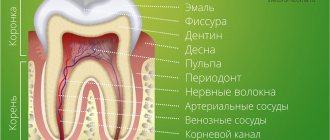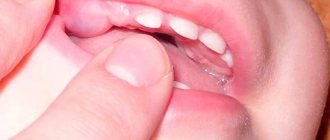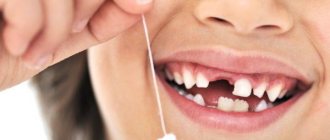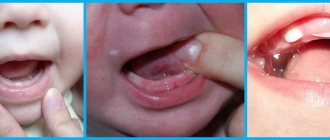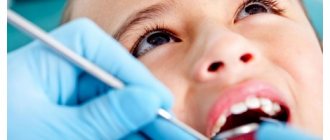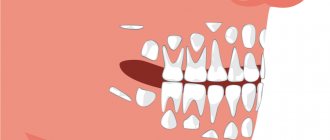Cough
Most often, children develop a wet cough during the period of the appearance of incisors, canines and molars. His attacks are rare. This usually happens in a horizontal position when the child is lying down. It goes away in 2-3 days. But, young mothers should remember that frequent manifestations of a wet cough may indicate serious illness. You need to see a doctor to rule out bronchitis and pneumonia. If symptoms are severe, you should not delay a visit to the pediatrician.
Vomit
This unpleasant state at the birth of units can be explained.
- With strong salivation, the child does not have time to swallow saliva. It drains, accumulates in the mouth and is expelled by reverse peristalsis.
- Painful condition, crying and screaming contribute to swallowing air. It gathers in large quantities, props up the diaphragm, the little ones arch and saliva, along with food, spews out.
- Refusal to eat provokes mothers to force-feed. In such a situation, food is rejected by the body.
Vomiting can be provoked by high temperature, decreased immune status, which is fraught with the introduction of pathogenic microflora. Intoxication leads to vomiting. This is how the body cleanses itself of toxins. It is important to avoid dehydration. Remember that in a child’s body it occurs quickly. Therefore, contacting a pediatrician is mandatory.
An examination of the oral cavity will reveal a violation of the closure of the jaws and their uneven growth. This may be a consequence of prolonged use of the pacifier. Correcting the bite in children is an important component of overall health. A mandatory visit to the pediatric dentist is carried out no later than 6 months of age. The doctor will evaluate the position of the upper and lower lips, the condition of the frenulum, and the features of the maxillofacial structure.
Diarrhea
Watery bowel movements, that is, diarrhea, are also noted at the birth of the masticatory organs. If stool is not frequent, no more than 2-3 times a day, and this trouble lasts from 1 to 3 days, mothers should not worry. If you have frequent bowel movements with the appearance of blood clots, you should contact your pediatrician, especially when you experience abdominal pain. You cannot self-medicate, it is dangerous for the baby’s health. In such a situation, dehydration is detrimental. Only a doctor can make the correct diagnosis and help cope with the problem.
When teeth start cutting
Teething usually begins between 6 and 12 months of age. But sometimes the first teeth may appear earlier or, conversely, later. In very rare cases, babies are born with a tooth already erupted, or the first tooth may emerge in the first few weeks of life. Watch for symptoms of teething: swollen gums, excessive salivation, the baby tries to chew on a fist or finger. These signs may indicate that your baby will soon have his first teeth.
When the first teeth are slow to appear
It's good to remember that teething is not a competitive sport. And your baby’s first teeth will erupt in due time. Therefore, do not worry if your peers have already lost their first tooth or several, but your baby has not yet. The timing of teething—or the age range at which teeth begin to cut—can be quite wide. Teething is more likely to occur between 6 and 12 months of age, and the first tooth may appear as early as three or four months, or even as early as 14 months. In some children, the timing of teething may be outside this range on both sides. Genetics influences dental timing. If you are concerned about your baby's teeth or lack thereof and have questions about caring for baby teeth, consult your pediatrician or pediatric dentist.
Teething order
Teething progresses differently for each baby, but often the two lower front teeth appear first, followed by the two upper front teeth. We will tell you more about when baby teeth usually appear in the section “Teething Timing”
The urge to scratch the gums and drooling
Children generally tend to put everything in their mouths, but as teething begins, this need may increase noticeably. If your baby always wants to scratch his gums on something, this is a clear sign that he is teething. Make sure that the child cannot reach dangerous objects that could block his airway, and let the baby chew special teething rings.
Another sign of rapid teething is excessive drooling: in some babies it can be so intense that their clothes become wet through, and skin irritation appears around the mouth and chin. To help keep your baby comfortable and rash-free, gently wipe away any saliva from his face and change wet clothes as needed.
How long does it take to cut teeth?
The duration of teething may vary. However, at some point between your baby's second and third years, he will be able to boast a full set of 20 baby teeth. That is, in general, teething lasts about two years. If your baby experiences discomfort while teething, keep in mind that the unpleasant signs of teething will gradually subside. Teething symptoms usually begin a few days before the tooth emerges, then the pain subsides until the new tooth begins to emerge.
How many baby teeth will the baby have?
Your baby's first teeth are called baby teeth. By the time the child is two and a half to three years old, the baby will have a full set of 20 baby teeth.
When a child turns six or seven years old, baby teeth will begin to fall out, giving way to permanent ones. Many years must pass before all 32 permanent teeth appear, and for some time the baby will have both baby and molar teeth at the same time.
| Briefly |
|
Teething symptoms
Play Icon Created with Sketch.
Sometimes a tooth may erupt without any symptoms at all, and in other cases, teething symptoms may appear about three to four days before the tooth itself appears.
Here are some signs of teething:
- Restless behavior and crying.
When teeth begin to cut, the baby may be capricious and restless.
- Sleep problems.
Due to discomfort and pain during teething, your baby may wake up more often at night.
- Salivation.
When teething, babies usually drool a lot. Experts explain this by saying that saliva helps soothe sore gums.
- The baby puts objects into his mouth and tries to chew.
Teething babies often try to keep toys, their own fingers, and special teethers in their mouths. This way they massage the gums and relieve discomfort.
- Inflamed and swollen gums.
The area where the tooth breaks through may be red, inflamed, and swollen.
- Slight increase in temperature.
During teething, the baby may have a slightly elevated temperature. It is unlikely that your baby will have a fever or a temperature above 38.3°C. If your baby experiences severe discomfort or a teething temperature above 38.3°C (or 38°C for infants under three months), consult your pediatrician.
| Briefly |
Signs of teething:
|
How to understand that teeth have started to cut?
The following symptoms will indicate that a child is getting his first baby tooth:
- severe crying, frequent whims of the baby;
- increased salivation;
- slight increase in temperature;
- frequent excitability;
- refusal of food;
- upset stomach (diarrhea).
Of course, the above symptoms individually can indicate not only that the child is getting his first teeth. For example, whims and frequent excitability in a baby can be caused by stress due to moving to a new apartment, fever by a cold, and diarrhea by an allergy to a particular product. Usually, the eruption of the first teeth in children provokes several, or even all, of these signs at once.
Teething order
In what order and how do baby teeth erupt? This happens differently for each baby and at different times. But there is a generalized teething schedule:
Upper teeth
- Central incisors
(front teeth): 8–12 months.
- Lateral incisors
(teeth on either side of the front teeth): 9–13 months.
- Fangs
(pointed teeth on either side of the lateral incisors): 16–22 months.
- First molars
(back teeth used for grinding food): 13–19 months.
- Second molars
(posterior teeth filling the last gaps): at 25–33 months.
Lower teeth
- Central incisors
(front teeth): 6–10 months.
- Lateral incisors
(teeth on either side of the front teeth): 10–16 months.
- Fangs
(pointed teeth on either side of the lateral incisors): 17–23 months.
- First molars
(back teeth used for grinding food): at 14–18 months.
- Second molars
(posterior teeth filling the last gaps): at 23–31 months.
How to help your baby teething
In this video, we share four ways to help your baby through teething: Teething can be uncomfortable for some babies. There is no one magic solution to relieve discomfort, and you may need to experiment before you discover one that works for your child. Among the ways to help your baby teething, there are two most popular:
- Give your baby a teether.
Chewing the teether, the baby massages the gums. Some teethers can be cooled in the refrigerator, this will bring additional relief to the baby. But don't put your teether in the freezer - this can make it too hard and cold for sensitive gums. For safety reasons, never hang teethers around your baby's neck.
- Massage the child's gums.
Try massaging your baby's gums with your clean finger.
How to care for baby teeth
It is important to start caring for your teeth as soon as your first teeth appear. Baby teeth will have to serve the baby for several years before they are replaced by molars. And teaching your baby to dental care rituals will help him properly take care of the health of his teeth and gums throughout his life. Preventing caries in baby teeth is just as important as it is in permanent teeth because caries can affect the development of molars and cause other dental problems such as pain and infections.
YOU MAY ALSO LIKE
First teeth
How to brush your child's teeth and take care of their health
Teeth cleaning
Regular brushing of baby teeth is a key part of dental care. Brush your baby's teeth twice a day with gentle movements and teach him to this mandatory ritual. Below we share tips on how to brush your baby’s teeth, as well as teach your child to do it themselves.
- Brush your teeth at least twice a day, and always brush your teeth after your child eats something sweet and after the last meal or drink of the day.
- Squeeze a little toothpaste with fluoride (from one year to one year you can just brush) onto a baby toothbrush with soft bristles. Brush each tooth thoroughly, trying to reach all surfaces. When your child is two years old, you can squeeze a pea-sized amount of toothpaste onto the brush. You will need to teach your child to rinse and spit rather than swallow the toothpaste.
- It doesn’t matter in which direction to clean. The main thing is to brush each tooth from all sides and reach the back teeth.
- At first, brushing your teeth will be entirely your responsibility. Toddlers should be gradually taught to brush their teeth on their own under your supervision. Until your child is seven or eight years old, supervise how he brushes his teeth. You might like some of these ideas for making brushing your teeth more fun.
BEST PRODUCT
Pampers® Active Baby Dry™
Nutrition
Your baby's diet is an important part of dental health. Avoid giving your child sugary drinks such as fruit juices and sodas, gum, toffee, and hard candy. Do not let your baby fall asleep with a bottle or sippy cup containing milk, formula, juice, etc., as this can cause the accumulation of sweet liquid in the mouth and lead to tooth decay.
Visits to the dentist
Regular dental checkups are of utmost importance to maintain your child's oral health. Typically, the first visit to the dentist should be around six months after the first tooth emerges, or when the child is 12 months old, whichever comes first.
But if you have any questions or concerns, contact your pediatric dentist—no matter the child’s age. Your pediatrician may also examine your gums and teeth during one of your regular checkups.
| Briefly |
How to care for baby teeth:
|
When to see a doctor
If your baby has a fever, is fussy, has diarrhea, or has any other signs of teething, and you are not sure whether your baby's condition is due to teething or one of the common childhood illnesses, your best bet is to see a doctor. The doctor will be able to determine the cause of the illness and, if necessary, recommend treatment.
It is also recommended to consult a pediatrician if your baby experiences severe discomfort when teething. Your doctor may recommend a pain reliever and also rule out other causes of pain and discomfort other than teething. Do not use teething gels to numb your gums as they are not safe.
You should also consult a doctor if your teeth are injured, for example, when a tooth is knocked out or chipped.
When should you worry?
The listed signs of the appearance of the first baby tooth should not bother mom, dad and grandmother too much. The following symptoms may be a reason to contact your pediatrician:
- Early appearance of the first teeth. In rare cases, newborns develop teeth immediately after birth. This may indicate endocrine pathology and requires examination by an endocrinologist.
- A significant delay in teething may also indicate various metabolic disorders in children and requires medical intervention.
- Incorrect appearance order . If, instead of the baby’s first incisors, molars or fangs begin to peck, such disharmony may indicate anomalies in the baby’s development or be a consequence of illnesses that the woman suffered during pregnancy.
- Temperature above 39 degrees. When the first teeth erupt in children, the temperature rises slightly. If your baby becomes hot and the high temperature lasts for several hours, call a doctor immediately.
Baby teeth: interesting facts
Want to learn more about teething and baby teeth? Here are some fun facts about your baby's teeth:
- On average, about four baby teeth come out every six months. And this will continue until all 20 come out.
- Girls may start teething earlier than boys.
- The lower teeth usually erupt first.
- The first teeth usually erupt almost simultaneously on the right and left.
- Baby teeth are usually smaller and whiter than the permanent teeth that will replace them in a few years.
- From about age four, your child's face and jaw will begin to grow and change shape, and gaps will appear between the teeth. This is completely normal: it makes room in your mouth for larger adult teeth.
- At seven or eight years old, permanent teeth will begin to appear. Because it will take some time for a child to develop a full set of adult teeth, within a few years the child will have both baby and permanent teeth at the same time.
- Children only grow 20 baby teeth, and will have more molars. During adolescence or 20s, a child will have between 28 and 32 permanent teeth.
FREQUENTLY ASKED QUESTIONS
- Signs of teething:
Baby is cranky and in a bad mood. - The baby doesn't sleep well.
- Heavy salivation.
- The baby tries to chew objects and his fingers.
- The baby's gums are swollen.
- Give him a teether
Symptoms of teething include: bad mood and tearfulness, excessive salivation, swelling and redness of the gums. If you are not sure what explains your baby's discomfort, be sure to consult a doctor.
Signs of teething:
- The baby is whiny and capricious.
Eruption of baby teeth. Symptoms.
Teething in children is not a disease, but a natural physiological process. It can be accompanied by different symptoms in different children.
Typical symptoms of teething:
- Swollen gums and increased salivation are a characteristic sign of the onset of teething. These phenomena can be observed 3-6 weeks before the appearance of the first tooth. Drooling is due to irritation of the nerve endings in the mouth. Redness, swelling and inflammation of the gums are caused by increased blood supply to the areas above the growing teeth. These manifestations cannot be avoided, but their intensity can be reduced. The drug Dantinorm Baby reduces swelling and soreness of the gums, relieves inflammation.
- The child makes intense chewing movements with his gums - this is how he tries to get rid of the obsessive itching. To help your baby relieve discomfort, offer him a special chewing ring. You can use any dense rubber toy if you are sure that the material from which it is made is safe. The item should not have sharp edges or crumble into small pieces. You can pre-cool the ring or toy in the refrigerator.
- A wet cough in a baby during this period may be caused by an increase in the amount of saliva. Cough associated with teething does not require treatment. However, if he becomes intrusive, wheezing and profuse sputum are observed, it is worth showing the baby to the pediatrician.
- A child’s runny nose appears due to the activation of the glands of the nasal cavity. Normal nasal discharge in this case should be watery and clear. You can help your baby by promptly clearing his nose of secretions.
- The increase in temperature during teething is short-term and transient. Low-grade fever (37-38 °C) should not be “brought down” with narrowly targeted medications. To reduce temperatures above 38 °C, it is recommended to use paracetamol-based medications, drink plenty of fluids, and wet wipes. A high temperature for more than two days is a reason to urgently consult a doctor!
- Digestive disorders and loss of appetite are caused by the restless state of the child and a change in the usual diet. Diarrhea can be caused by excessive swallowing of saliva. In this case, the stool should not be too frequent, watery, without a pronounced unpleasant odor. If bloody or mucous streaks appear, stools become more frequent and the temperature rises, you need to show your baby to a pediatrician to rule out infection. One of the accompanying symptoms may be diaper rash in the baby's perineum, the reason for this is excessive salivation during teething, and as a result, more acidic and fermented stools, affecting the delicate skin of the baby's bottom, resulting in a rash and irritation. By the way, a rash from excessive drooling can also appear around the baby’s mouth.
- Older children may complain of nagging pain in the ears, while younger children may complain of pulling or scratching their ears.
- Behavioral disturbances when feeding and falling asleep - the child becomes more restless and irritable
Dantinorm Baby helps to quickly relieve all the main symptoms of teething in a child. It contains plant components that help reduce inflammation and soreness of the gums and normalize digestion.
The drug is available in a convenient form, is easy to use and has virtually no contraindications. In any case, do not hesitate to show your child to the pediatrician once again, so as not to confuse the symptoms of teething with a more serious cause of the baby’s illness.
The order of eruption of baby teeth:
Timing and sequence of teething in children. One of the important milestones in the development of a baby is the eruption of the first teeth, which begins at the age of about 3 months and lasts until 2.5-3 years. Normally, a baby (i.e., up to one year) should erupt eight teeth in the following order.
- The two lower incisors usually erupt first. This occurs between 3 and 9 months.
- Next, they are joined by the upper incisors with a one-month delay, i.e., between 7 and 10 months.
- At the age of 9 to 12 months, first the lateral incisors on the upper jaw and then the lateral (second) incisors on the lower jaw should erupt in your baby’s mouth. Thus, a one-year-old child normally moves from the status of an infant to a toddler with eight incisors . After a year, teething occurs almost continuously in a child.
- In the interval of 12-18 months, the first upper molars (the so-called “first molars”) erupt, and 13-19 months – the first molars on the lower jaw.
- At 16-20 and 17-22 months, the eruption of canines should be expected on the upper and lower jaws, respectively.
- At 20-23 and 24-26 months, the child’s second molars erupt, first on the lower and then on the upper jaw (“second molars”). However, due to hereditary factors, as well as the child’s nutritional characteristics, these dates can significantly degree to change. Therefore, there is no need to panic with minor deviations. If in doubt, you should consult a specialist.

